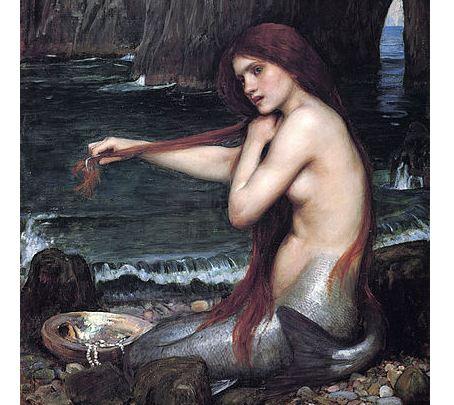People are asking, prompted by a new special on Mermaids, whether mermaids exist or not.
A look over the years shows that many people around the world have sighted or even directly experienced mermaids. Here’s a timeline of some of the major sightings and experiences, including Christopher Columbus, John Smith, and William Shakespeare.
First Century AD: Pliny the Elder writes about Nereids, or women with rough, scaly bodies like fish. They are “sitting upon dolphins, or ketoi, or hippocamps,” in some cases, he writes in Natural History.
Pliny describes how the legatus of Gaul wrote to the late Emperor Augustus about “a considerable number of nereids” being “found dead upon the seashore.” Further, “I have, too, some distinguished informants of equestrian rank, who state that they themselves once saw in the ocean of Gades a sea-man,” Pliny writes, according to a translation by the University of Chicago.
Fifth Century AD: In the book Physiologus, which is said to have been written or compiled in Greek by an unknown author, there is a portion dedicated to “The Nature of the Mermaid” that is translated by graduate student Mary Allyson Armistead as follows:
“In the sea there are many marvels.
The mermaid is like a maiden:
In breast and body she is thus joined:
From the navel downward she is not like a maid
But a fish very certainly with sprouted fins.
This marvel dwells in an unstable place where the water subsides.
She sinks ships and causes suffering,
She sings sweetly —this siren—and has many voices,
Many and resonant, but they are very dangerous.
Sailors forget their steering because of her singing;
They slumber and sleep and wake too late,
And the ships sink in a whirlpool and cannot surface anymore.
But wise and wary men and are able to return;
Often they escape with all the strength they have.
They have said of this siren, that she is so grotesque,
Half maid and half fish: something is meant by this.”
Article Continues after the discussion. Vote and comment
[tok id=3118203983fcd9c541604c8ab1b7db35 partner=1966]
Sometime between 1040 and 1105: Rabbi Shlomo Yitzchaki, or Rashi, describes mermaids in the Talmud.
“There are fish in the sea with which half is in the form of man and half in the form of a fish, called sereine in Old French,” he wrote.
Also, not too long after, the Moshav Zekeinim, a commentary on the “Torah” by the medieval Tosafists, explains mermaids while calling them sirens, according to the book Sacred Monsters.
“This refers to the creature in the sea which is similar in part to a person, from the navel upwards, and it is similar to a woman in all aspects, in that it has breasts and long hair like that of a woman, and from the navel downwards it is a fish,” it is written in the commentary. “And it sings beautifully, with a pleasant voice.”
13th Century: Bartholomew Angelicus, in De Propietatibus Rerum, describes a mermaid, and tells of her stealing sailors from their ships.
Middle of 13th Century: Speculum Regale, or The King’s Mirror, is written in Old Norse, a translated version appearing several centuries later.
In the book there is a description of a creature found off the shores of Greenland.
“Like a woman as far down as her waist, long hands, and soft hair, the neck and head in all respects like those of a human being. The hands seem to be long, and the fingers not to be pointed, but united into a web like that on the feet of water birds. From the waist downwards this monster resembles a fish, with scales, tail, and fins. This shows itself, especially before heavy storms. The habit of this creature is to dive frequently and rise again to the surface with fishes in its hands. When sailors see it playing with the fish, or throwing them towards the ship, they fear that they are doomed to lose several of the crew ; but when it casts the fish from the vessel, then the sailors take it as a good omen that they will not suffer loss in the im-pending storm. This monster has a very horrible face, with broad brow and piercing eyes, a wide mouth and double chin.”
1389: The book Eastern Travels of John of Hesse is published, in which many perils during a voyage are relived. At one point the author writes: “We came to a stony mountain, where we heard syrens singing, mermaids who draw ships into danger by their songs. We saw there many horrible monsters and were in great fear.”
1403: A mermaid drifts inland through a broken dyke on the Dutch coast during the heavy storm. She was spied by some local women and their servants, “who at the first were afraid of her, but seeing her often, they resolved to take her, which they did, and bringing her home, she suffered herself to be clothed and fed with bread and milk and other meats, and would often strive to steal again into the sea, but being carefully watched, she could not.”
The mermaid later learned how to sew but never spoke. She died 15 years after she was discovered. John Swan, an English minister, describes the story in the 1635 book Speculum Mundi.
The book also includes the following describing mermaids:
“Transform'd to fish, for their bold surquedry :
But th' upper half their hew retayned still,
And their sweet skill in wonted melody
Which ever after they abused to ill,*
T' allure weake travellers whom gotten they did kill.”
1493: Christopher Columbus spots three mermaids rise high from the sea. Columbus wrote in his ship’s journal: “They were not as beautiful as they are painted, although to some extent they have a human appearance in the face.” He also noted that he had seen similar creatures off the coast of West Africa.
1560: According to Curious Myths of the Middle Ages by Sabine Baring-Gould: “Near the island of Mandar, on the west of Ceylon, some fishermen entrapped in their net seven mermen and mermaids, of which several Jesuits, and Father Henriques, and Bosquez, physician to the Viceroy of Goa, were witnesses. The physician examined them with a great deal of care, and dissected them. He asserts that the internal and external structure resembled that of human beings.”
1590: William Shakespeare is believed to have written Midsummer Night’s Dream between 1590 and 1594. In it, he writes:
“I sat upon a promontory,
And heard a mermaid on a dolphin’s back,
Uttering such dulcet and harmonious breath,
That the rude sea grew civil at her song;
And certain stars shot madly from their spheres
To hear the sea-maid’s music.”
Soon after, he continues. “Come over here, Puck. You remember that time I was sitting on a rocky coast when I head a mermaid? She was riding on a dolphin’s back. Her singing was so sweet and pure that the rough sea grew calm and stars sot madly about the sky on hearing the sea-girls song.”
1608: Explorer Henry Hudson recounts an experience in the ship’s journal that happened on June 15, while sailing through the Bering Sea off the top of Norway.
“This morning one of our company, looking overboard, saw a mermaid, and calling up some of the company to see her, one more came up, and by that time she was come close to the ship’s side, looking earnestly on the men. A little while after a sea came and over- turned her. From the navel upward her back and breast were like a woman’s, as they say that saw her ; her body as big as one of ours ; her skin very white, and long hair hanging down behind, of colour black. In her going down they saw her tail, which was like the tail of a porpoise, and speckled like a mackerel. Their names that saw her were Thomas Hilles and Robert Rayney.”
Later, in the mid 1800’s, in an analysis of the incident in The Romance of Natural History, naturalist Philip Henry Gosse says that the usual claim of sailors mistaking manatees for mermaids won’t work here.
“Whatever explanation may be attempted of this apparition, the ordi-nary resource of seal and walrus will not avail here. Seals and walruses must have been as familiar to these polar mariners as cows to a milkmaid. Unless the whole story was a con-cocted lie between the two men, reasonless and objectless, and the worthy old navigator doubtless knew the character of his men, they must have seen some form of being as yet unrecognized.”
1614: Captain John Smith, of Pocahontas fame, sees a mermaid off the coast of Massachusetts.
He writes that “the upper part of her body perfectly resembled that of a woman, and she was swimming about with all possible grace near the shore.” It had “large eyes, rather too round, a finely shaped nose (a little too short), well-formed ears, rather too long, and her long green hair imparted to her an original character by no means unattractive.”
1619: Two senators in Norway capture a merman, according to Adventures in Unhistory. The senators, Ulf Rosensparre and Christian Hollh, decided to release the merman back into the sea.
1739: The Gentleman’s Magazine describes in an issue an experience with a creature.
“Some fisherman near the City of Exeter drawing their nets ashore, a Creature leap‘d out, and run away very swiftly, not being able to overtake it, they knock’d it down by throwing sticks after it,” the description reads, according to Adventures in Unhistory.
“At their coming up to it, it was dying, having groan‘d like a human creature: Its feet were webb’d like a duck’s, it had eyes, nose, and mouth resembling those of a man, only the nose somewhat depress’d; a tail not unlike a salmon’s, turning up towards its back, and is four feet high.” It was publicly shown in the city.
1797: William Munro, a schoolteacher in Scotland, writes a letter to a Dr. Torrance in Glasgow, which is published in The Times of London on Sept. 8, 1809.
Munro writes:
“About twelve years ago when I was Parochial Schoolmaster at Reay, in the course of my walking on the shore of Sandside Bay, being a fine warm day in summer, I was induced to extend my walk towards Sandside Head, when my attention was arrested by the appearance of a figure resembling an unclothed human female, sitting upon a rock extending into the sea, and apparently in the action of combing its hair, which flowed around its shoulders, and of a light brown colour. The resemblance which the figure bore to its prototype in all its visible parts was so striking, that had not the rock on which it was sitting been dangerous for bathing, I would have been constrained to have regarded it as really an human form, and to an eye unaccustomed to the situation, it must have undoubtedly appeared as such. The head was covered with hair of the colour above mentioned and shaded on the crown, the forehead round, the face plump. The cheeks ruddy, the eyes blue, the mouth and lips of a natural form, resembling those of a man; the teeth I could not discover, as the mouth was shut; the breasts and abdomen, the arms and fingers of the size in which the hands were employed, did not appear to be webbed, but as to this I am not positive. It remained on the rock three or four minutes after I observed it, and was exercised during that period in combing its hair, which was long and thick, and of which it appeared proud, and then dropped into the sea, which was level with the abdomen, from whence it did not reappear to me, I had a distinct view of its features, being at no great distance on an eminence above the rock on which it was sitting, and the sun brightly shining.”
He continues:
“Immediately before its getting into its natural element it seemed to have observed me, as the eyes were directed towards the eminence on which I stood. It may be necessary to remark, that previous to the period I beheld the object, I had heard it frequently reported by several persons, and some of them person whose veracity I never heard disputed, that they had seen such a phenomenon as I have described, though then, like many others, I was not disposed to credit their testimony on this subject. I can say of a truth, that it was only by seeing the phenomenon, I was perfectly convinced of its existence.
If the above narrative can in any degree be subservient towards establishing the existence of a phenomenon hitherto almost incredible to naturalists, or to remove the scepticism of others, who are ready to dispute everything which they cannot fully comprehend, you are welcome to it from,
Dear Sir,
Your most obliged, and most humble servant,
WILLIAM MUNRO”
1801: Dr. Chisolm recounts a visit four years prior to the island of Berbice in the Carribbean. The residents call mermaids mene mamma, or mother of waters. Governor Van Battenburgh gives the following description to Chisolm:
“The upper portion resembles the human figure, the head smaller in proportion, sometimes bare, but oftener covered with a copious quantity of long black hair. The shoulders are broad, and the breasts large and well formed. The lower portion resembles the tail-portion of a fish, is of immense dimension, the tail forked, and not unlike that of the dolphin, as it is usually represented. The colour of the skin is either black or tawny. The animal is held in veneration and dread by the Indians, who imagine that the killing it would be attended with the most calamitous consequences. It is from this circumstance that none of these animals have been shot, and, consequently, not examined but at, a distance. They have been generally observed in a sitting posture in the water, none of the lower extremity being discovered until they are disturbed; when, by plunging, the tail appears, and agitates the water to a considerable distance round. They have been always seen employed in smoothing their hair, or stroking their faces and breasts with their hands, or something resembling hands. In this posture, and thus employed, they have been frequently taken for Indian women bathing.”
1822: A young man, John McIsaac of Scotland, testifies under oath that he saw an animal that had a white upper half with the shape of the human body, while the other half was covered with scales and had a tail, according to a story in the London Mirror. The sighting took place in 1811. McIsaac describes the creature as having long, light brown hair, being between four and five feet long, and having fingers close together.
“It continued above water for a few minutes, and then disappeared,” according to the article. “The Minister of Campbeltown, and the Chamberlain of Mull, attest his examination, and declare that they know no reason why his veracity should be questioned.”
1830: Villagers at Benbecula, in the Outer Hebrides off the west coast of Scotland saw a small woman on shore. They tried capturing it, but failed, so they pelted it with rocks. A few days later,its corpse washed ashore, according to Hidden Animals. They then examined it. “The upper part of the body was about the size of a well-developed child of three or four years of age, with an abnormally developed breast. The hair was long, dark, and glossy, while the skin was white, soft, and tender. The lower part of the body was like a salmon, but without scales.” The creature was buried in a coffin later on.
1842: Phineas Barnum, of Barnum and Brothers fame, got connected with what was said to be a mermaid who had been caught near the Feejee Islands in the South Pacific. There is much debate whether the mermaid was a mermaid or something else.
On the supporting side, the New York Sun had a review which in part said: “We’ve seen it! What? Why that Mermaid! The mischief you have! Where? What is it? It’s twin sister to the deucedest looking thing imaginable—half fish, half flesh; and ’taken by and large,' the most odd of all oddities earth or sea has ever produced.”
In a portion of an autobiography written by Barnum, published by the Department of History and Art History at George Mason University, Barnum says that he obtained the specimen from the estate of a dead sailor, who had purchased it from Japanese sailors.
Barnum recounts going to his naturalist to ascertain the “genuineness of the animal.” His naturalist tells him that he cannot conceive of how it was manufactured, “for he never knew a monkey with such peculiar teeth, arms, hands, etc., nor had he knowledge of a fish with such peculiar fins.”
Writes Barnum: “Then why do you suppose it is manufactured?” I inquired. “Because I don’t believe in mermaids,” replied the naturalist. “That is no reason at all,” said I, “and therefore I'll believe in the mermaid, and hire it.” Barnum showed the animal in his museum in New York and got out of it quite a bit of money.
Others say that the whole thing was a hoax, and that it was created by Japanese artisans.
1857: The Shipping Gazette reported that Scottish seaman had spotted a creature off the coast of Britain.
“We distinctly saw an object about six yards distant from us in the shape of a woman, with full breast, dark complexion, comely face, and fine hair hanging in ringlets over the neck and shoulders. It was about the surface of the water to about the middle, gazing at us and shaking its head. The weather being fine, we had a full view of it and that for three or four minutes,” said John Williamson and John Cameron.
1947: A old fisherman in Scotland reported that he had seen a mermaid in the sea about twenty yards from the shore, sitting combing her hair on a floating herringbox used to preserve live lobsters, according to Sir Arthur Waugh in The Folklore of the Merfolk. “Unfortunately, as soon as she looked round, she realized that she had been seen, and plunged into the sea,” he writes. “But no questioning, says Mr Maclean, could shake the old fisher- man’s conviction: he was adamant that he had seen a mermaid. So one never knows!”
2008: A sighting of a mermaid happened in Suurbraak, a village in the Western Cape of South Africa, reported Aldo Pekeur, a correspondent for the New Zealand Herald. A resident of the village, Daniel Cupido, said he and his friends were next to the river around 11:30 p.m. when they heard something like someone “bashing on a wall.” Cupido went toward the sound, and found a figure “like that of a white woman with long black hair thrashing about in the water”.
Cupido said he tried to help the woman but the woman made “the strangest sound,” which Dina, Cupido’s mother, said was so sorrowful “my heart could take it no more.” The creatures are described as Kaaiman, or half human and half fish creatures living in deep pools. Suurbraak tourism officer Maggy Jantjies said she knew the people who saw the Kaaiman well, and that they did not misuse alcohol
2009: The reports from dozens of people of seeing mermaids spurred the town council in Kiryat Yam, near Haifa, to offer $1 million to anyone who can prove by photo or capture that mermaids do exist.
“Many people are telling us they are sure they’ve seen a mermaid and they are all independent of each other,” council spokesman Natti Zilberman told Sky News. “People say it is half girl, half fish, jumping like a dolphin. It does all kinds of tricks then disappears.”
2012: An official in Zimbabwe said that mermaids were hounding government workers off dam sites in several different areas. Water Resources Minister Sam Sipepa Nkomo told a senate committee in March that traditional chiefs were going to perform rituals to get rid off the mermaids believed to live in reservoirs in Gokwe and Mutare, where workers are afraid to go, according to Voice of America. Some workers reportedly went missing while others have refused to go back to install water pumps.
Traditional leader chief Edison Chihota of Mashonaland East told the media outlet that mermaids exist. “As a custodian of the traditional I have no doubt,“ chief Chihota said. ”For anyone to dispute this is also disputing him or herself.”
Daniel He contributed research to this article





